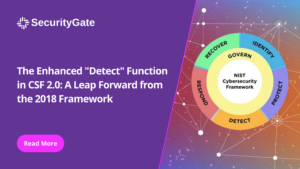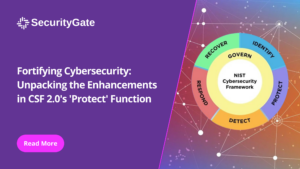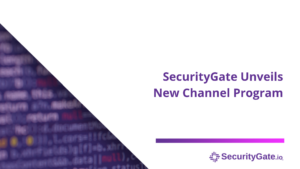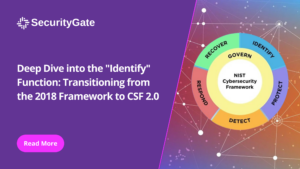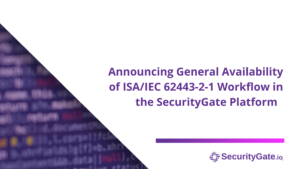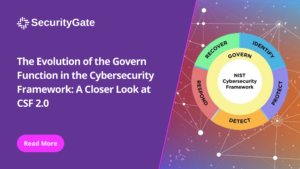Experienced CISOs and CIOs, having navigated at least one budget cycle, face the critical task of enhancing cybersecurity measures in their enterprises. This blog post delves into three pivotal strategies for effective cyber risk management:
- Comprehensively understanding organizational cyber risks
- Setting a universally comprehensible cybersecurity goal, and
- Fostering a culture of participation with incentives.
It also highlights essential features to look for in cybersecurity solutions: standardized risk language, repeatable processes, and a user-friendly dashboard.
Understanding Organizational Cyber Risks
In-depth risk assessments are crucial in identifying and understanding cyber threats that could impact your business. Key activities include:
– Analyzing third-party vendor risks.
– Uncovering vulnerabilities within IT infrastructure.
– Evaluating the impact of industry-specific cyber threats against existing operational assets
For effective cyber risk management, prioritize solutions that offer standardized risk language. This facilitates clear communication across departments, enhancing understanding and management of cyber risks.
Setting a Universal Cybersecurity Goal
Developing a clear, measurable, and achievable cybersecurity goal is essential in aligning your organization’s efforts towards enhanced cyber safety. When evaluating cybersecurity solutions, consider those that establish a repeatable process. This feature is crucial for scaling your cybersecurity practice and ensuring you can track your results.
Creating a Culture of Cybersecurity Participation
Encouraging active participation in cybersecurity practices is vital. This can be achieved through:
– Recognition programs for excellent cybersecurity practices.
– Engaging cybersecurity training approaches.
– Performance metrics that include cybersecurity compliance.
A solution with a simplified, intuitive dashboard is essential. It should provide a comprehensive view of your cybersecurity status, enabling easy understanding and engagement for all team members.
Choosing the Right Cybersecurity Solution
When selecting a cybersecurity solution, focus on:
- Standardized Risk Language: Opt for solutions that standardize cyber risk terminologies, enhancing clarity and consistency in risk communication.
- Establish Repeatable Processes: Choose solutions that establish repeatable processes to ensure you can scale your cybersecurity practice and ensure your results can be qualified and quantified.
- User-Friendly Dashboard: Select a solution with an easy-to-navigate dashboard that offers quick insights into your cybersecurity status, facilitating prompt decision-making and broad accessibility.
Conclusion
For CISOs and CIOs, transferring cyber risk involves effectively:
- Having a comprehensive understanding of risks.
- Setting clear goals.
- Fostering a culture of active participation.
Integrating a solution that aligns with these strategies—standardizing risk language, establishing repeatable processes, and providing an intuitive dashboard—is critical in implementing effective cybersecurity practices. Your enterprise can establish a strong defense in the evolving cybersecurity landscape with the right technology, aligned with strategic goals, and a committed team.
Interested in Learning More?
Here are five resources that provide valuable insights, guidance, and best practices:
- The National Institute of Standards and Technology (NIST):
- NIST Cybersecurity Framework
- NIST offers comprehensive guidance on managing and transferring cybersecurity risks. The framework includes risk assessment and risk management practices.
- ISACA – Information Systems Audit and Control Association:
- ISACA Knowledge Center
- ISACA provides resources and publications on cybersecurity, risk management, and governance, which can be valuable for CISOs and CIOs.
- (ISC)² – International Information System Security Certification Consortium:
- (ISC)² Resources
- (ISC)² offers educational resources, webinars, and publications focusing on various aspects of cybersecurity, including risk management.
- SANS Institute:
- SANS Reading Room
- SANS Institute provides whitepapers and research on cybersecurity topics, including risk transfer strategies.
- FAIR Institute – Factor Analysis of Information Risk:
- FAIR Institute Resources
- The FAIR Institute focuses on risk management and offers resources and tools based on the FAIR (Factor Analysis of Information Risk) framework.
By exploring these resources, CISOs and CIOs can gain a deeper understanding of effective strategies for transferring cyber risk and stay updated on the evolving landscape of cybersecurity. Additionally, attending industry conferences, workshops, and networking with peers can further enhance their knowledge and skills in this critical domain.
For more information about SecurityGate, subscribe to our newsletter.

